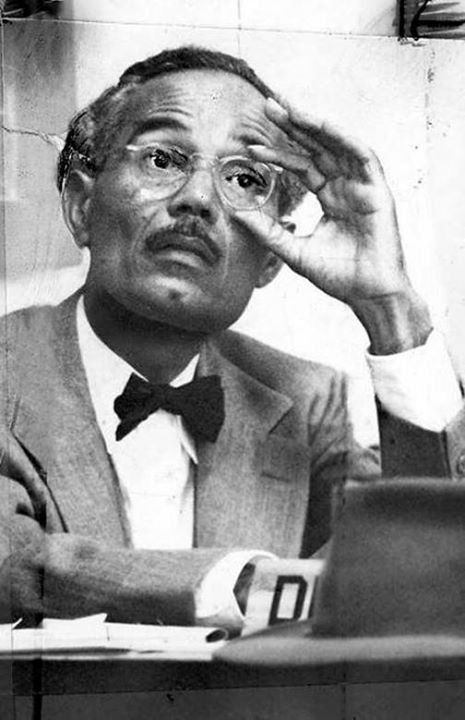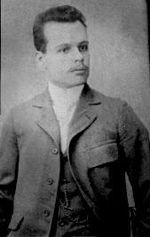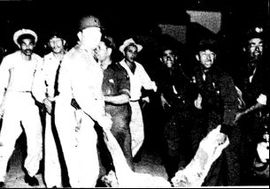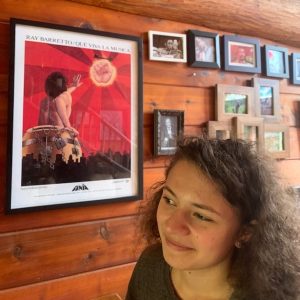
Vidal Santiago Diaz was the most famous barber in Puerto Rico, he even authored a book about his trade, ‘El Texto de Barberia Practica y Cientifica’, but, that was before the October 30th, 1950 incident, that made him into a legend throughout the island. Salon Boricua was Barrio Obrero’s neighborhood centre; a constant hub of activity, music and fierce debates; hated by Luis Muñoz Marin, and constantly surveilled by the FBI. But why were this barber and his little shop hated so much? Well, Vidal was no regular barber, he was a nationalist, president of the Santurce Municipal Board of officers of the PNPR and Pedro Albizu Campos’ personal barber.
Vidal Santiago Diaz was born on January 1, 1910 in Aguas Buenas, Puerto Rico. His grandfather was a highly respected man and well-known lector. Because so many people were illiterate in Puerto Rico at the time, lectores were hired to entertain workers by reading stories, newspapers and books. They would sit on a platform, mimicking characters’ voices and putting on different accents as they read stories. It was a way to hear the news and make the gloomy monotony of their jobs just a bit brighter. It was a good job, and a lector could make a middle class living. However, the United Porto Rico Sugar Company had other plans. After purchasing all of the tobacco plantations in and near Aguas Buenas, they built an enormous central (sugar refinery), the second largest on the island, and soon, lectors were no more. Vidal’s 60-year-old grandfather now had to cut cane, until one day he died of a heart attack right in the cane fields. Vidal promised himself he would never work in the fields that had taken his grandfather’s life. Soon after Vidal moved to Santurce’s working class, Barrio Obrero and found work at a barber shop owned by José Maldonado Roman (‘El Aguilar Blanca’), an old friend of Vidal’s grandfather. Though José liked Vidal, he probably regretted hiring him at first. Vidal ruined haircut after haircut until José figured out he had astigmatism, a condition that causes blurred and distorted vision, and bought him some glasses.


‘El Aguilar Blanca’
In May of 1930, Vidal met José’s friend who just happened to be the President of the Partido Nacionalista Puerto Rico, Pedro Albizu Campos. Tragically, José died in February of 1931, Albizu Campos later discovered that Maldonado was one of Cornelius P. Rhoads’ victims. Rhoads had transplanted cancer into Maldonado when he had gone to San Juan Presbyterian Hospital for anemia. Albizu Campos told Vidal, soon after, that according to Maldonado’s will Salon Boricua now belonged to him!
After some years, Vidal had come up with some new ways to bring in business. He advertised different haircuts he had seen in magazines on flyers and gave 50% off haircuts to balding men as well as senior discounts. He also gave free haircuts to unemployed sugar workers after the 1934 cane strikes.
A true turning point for Vidal came when he witnessed the Ponce Massacre. The inhumanity and horror of the massacre were riveting and horrifying for Santiago Diaz. It was also a turning point for the Nationalist movement, people began to live in fear. If it could happen at a peaceful march on Palm Sunday, it could happen anywhere. With Albizu Campos in Atlanta serving a 10-year prison sentence, hope and enrollment in the Cadets of the Republic plummeted. Vidal had to do something, he called José’s old associate, Captain Astro from Camp Las Casas 1. The Captain provided Vidal with weapons, taught him how to shoot and even snuck him onto the shooting range at the camp!
Upon Albizu Campos’s 1947 return to Puerto Rico, Vidal told him about the weapons he had stockpiled in a secret panel he had constructed. Albizu asked him who knew about it, and when Vidal said no one knew, he told him not to tell a soul. Don Pedro had rising concerns that there was a rat in the party, but he had no idea who it could be. Unfortunately, he was right. Though he didn’t know it then, a high-up member in the PNPR had been informing the FBI for 20 years.
In September 1950, Vidal Santiago Diaz was kidnapped by FBI agents. A hood was put over his head and he was taken to The Ramey Air Force Base, (that occupied more than 3,000 acres in Aguadilla, Puerto Rico,) informally known as the ‘Academy of Truth’. When the hood was taken from his head he saw that he was being taken into unfinished US Air Force barracks, which were being used to detain and torture prisoners. Vidal was brought in front of a man who introduced himself as Mr Rolf, he said he was responsible for Vidal’s arrest and the carpeta that had led to it. He asked Vidal where the guns were. Vidal answered that he didn’t know anything.
Rolf then called someone called Moncho and told him to come for another “session”. They took Vidal, tied him down and said he had 15 minutes to talk or else. Rolf returned and attempted to intimidate Santiago Diaz. Vidal demanded that he be taken to the real police and be addressed with the formal usted (you) rather than informal tu (you). The soldiers laughed at both. They then tied him to a copper bed frame and used electric shocks to torture him. After each one, Rolf screamed, “where are the guns?”
Back at Salon Boricua, one of the other barbers that worked there, Santo, knew something was wrong. The shop was deserted and Vidal’s beloved photo of José Maldonado was on the ground, torn in half. Santo, one of the other barbers and a few of Vidal’s regular customers searched the shop thoroughly, but couldn’t find a sign as to where the barber had gone.
Vidal was then taken to another room and waterboarded. He passed out, and when he awoke he was in a dark room. There he was fed rotten soup that was left over from the soldiers’ dinner.
After 2 weeks he had lost 10 lbs and could barely stand. Rolf again asked him about the guns. He told Rolf that he was only Albizu’s barber, he didn’t know about weapons. Rolf punched him out of his chair and a soldier kicked him in the stomach. They strapped him to a chair again and electrocuted him again. After shocking him several times he lost consciousness and in spite of throwing water on him, the torturers were unable to wake him.
They called a doctor to check if Vidal was dead. When he awoke, a doctor who introduced himself as Dr Hebb, injected him with something meant to confuse him. The doctor then began to question Vidal about the weapons. Vidal didn’t answer as he fell in and out of consciousness. The doctor even claimed to be Albizu Campos at one point in a desperate attempt to get him to talk. After this was unsuccessful, they had Faustino Diaz Pacheco come in and question him. Remember the rat Albizu Campos was looking for? It turned out to be Faustino. This betrayal wasn’t a one-time occurrence either, Faustino had been an informant for 20 years, giving detailed and personal accounts of the nationalists’ actions and plans.
Meanwhile, in Albizu Campos’s San Juan house, he and Faustino’s brother, (a loyal nationalist) Raimundo, were worried. Vidal was missing now for several weeks. Faustino had also disappeared.
When Vidal woke up he screamed that they could electrocute him again, he wasn’t going to talk. Soon after this, around 10 pm, soldiers came in, handcuffed him, put a hood over his head and shoved him into a car. When the car stopped they pushed him out and Rolf told him that if he left the shop without permission, he would be shot. Vidal, upon seeing one of the Santurce cadets of the Republic just a few blocks away screamed,”‘Faustino es la chota” (Faustino is the rat), Rolf slapped him in the face and drove off.
Soon after, one of the nationalists told Don Pedro, what he had been starting to suspect, that it was indeed Faustino Diaz Pacheco who was the informant. Albizu knew it was time to act. He already got word that someone from the CIA was out to assassinate him. He called for the revolution to start and it began on October 28, 1950.
Every morning the FBI gave Vidal a newspaper to show him what was happening to Nationalists around the island. He listened to the radio and heard that Griselio Torresola’s sister, Doris, had been shot in the throat and Pedro Albizu Campos’s house was surrounded and he was unable to leave. They had cut off his water and electricity and shut down all roads around his house. Five-hundred suspected Nationalists had been arrested. Five-thousand National guardsmen had been deployed in Puerto Rico to stop the uprisings. Governor Luis Munoz Marin had declared Martial Law and sent P47 thunderbolt warplanes to bomb Utuado and Jayuya. All Nationalist leaders were being arrested and most of them were being imprisoned in the horrible dungeon; ‘La Princesa’.
Vidal was trapped, his beloved shop, a prison. All he could do was watch the movement fall apart from the windows of the barbershop.
On October 30, Vidal discovered that the secret panel Pedro Albizu Campos had used to go to secret meetings was still there. Meaning with all the searches the FBI had conducted in the barber shop, they hadn’t found it. The false basement with guns and ammunition were also still there, untouched. He thought to himself that maybe the revolution still had a chance, but only if he could somehow tell Albizu Campos they still had weapons, a lot of them. He went outside and told the FBI he was ready to talk, however under one condition; ‘La Imparcial’ had to be present. He called the newspaper and waited.
Vidal saw the National Guard position high-powered machine guns aimed at the shop. He quickly realized they weren’t there to talk.
Damn it, time for Plan B! Vidal then did what any rational man does, grabs a bottle of Bacardi, makes a quick prayer and decides to take on 40 national guardsmen, FBI agents and policemen all by himself!
Several minutes later, an FBI agent walked in, gun drawn to bring him out. Vidal shot at the agent’s hat off! The National guard sprayed machine gun fire. Vidal ran upstairs and returned fire. They had not expected return fire and thought there must be more than one Nationalist inside. They ran for cover, and then gave orders to surround the building. Two Molotov cocktails came from the 2nd floor and lit a police car on fire. Vidal was then shot in the leg. The lieutenant grabbed a bull horn and the following was said.
“Vidal Santiago…we don’t want to hurt you.”
“Tell that to my leg, pendejo You shot it pretty good.”
“You and your friends…come out with your hands up, and no harm will come to you.”
“I don’t have any friends.”
“What you do have, is one minute. Come out or we’re coming in.”
“P’al carajo, maric*n.”
Two more Molotov cocktails came from the second floor. Firing continued. One of Albizu Campos’s speeches was being re-aired on the radio and Vidal turned the volume up all the way so the FBI, Insular Police, National Guard and reporters could hear the speech. By this time, 11 radio stations from all over the island, some as far as Mayaguez, (on the other side of the island) came. The fight was being broadcast live for the entire island to hear. Two and a half million people were listening to the gunfight, live!
A close friend of Vidal and a journalist, Luis Enrique ‘Bibi’ Marrero asked the lieutenant how many Nationalists were inside and he guessed about 20 – 30. Meanwhile, they unloaded M6A3 rockets and mounted MI919A4 machine guns. The reporter decided to try and intervene.
He and Vidal said the following:
(Luis Enrique) “Oye Vidal,”
(Vidal) “¿Quien habla?” (Who’s talking?)
(Luis Enrique) “It’s me, Bibí. How are you doing in there?”
(Vidal) “I’m all f’***ed up.”
(Luis Enrique) “¡ Coño Vidal, te ha’ hecho famoso! (Vidal you’re famous) Every radio station on the island is here.”
(Vidal) “I got a radio too. It’s got all this American crap.”
(Luis Enrique) “Do you need anything?”
(Vidal) “Yeah, a ticket to Cuba.”
(Luis Enrique) “Maybe we can arrange it. How many of you are -”
The National Guard began firing again. Vidal fired back. Then the reporters heard Vidal singing an Aguinaldo, except with some improvised lyrics,
Tengo una pistola Con manago de marfil Para matar to' los Yankees que vienen por ferrocarril I have a pistol. With a marble handle. To kill Yankees. Who come by railroad
, he sang as he shot back.
The reporters began laughing and the lieutenant asked for a translation. The reporters then began to all cheer for Vidal, infuriating the police and guardsmen. They blasted the shop with hundreds and hundreds of rounds of machine gun fire. Then they blasted 5 canisters of tear gas into the shop. At this point the fight had gone on for 3 hours!
Vidal was shot in the leg, ribs, and cheek and lost 3 fingers, the staircase and part of the roof collapsed on top of him. After there was no return fire, they very cautiously entered the shop.


They had expected to find 20 or 30 nationalists, however, they found one man, shot 4 times, covered with blood and glass under a collapsed staircase. A police officer, just to make sure he was dead, shot Vidal at point blank range in the head. Then mocking Vidal and laughing the officer said “Que Viva Porto Rica”. Vidal was dragged from his shop. Remarkably the barber opened his eyes. The police dropped him in disbelief, and one screamed, “I thought you shot him!”. The shop’s floor was covered with rubble, bullets and glass. What was left of the walls were splattered with his blood. Yet the barber was still alive. The reporters cheered and yelled into their microphones, “Vidal is alive”!
The police threw him in a van and he was taken to the hospital. The police then began to search what was left of the ravaged barbershop. They found broken weapons, and bullets, but they couldn’t find the secret panel.

Vidal’s head wound never fully healed. He was put on trial the day he left the hospital, for treason and intent to commit murder, even though the police were the ones who intended to murder him, and sentenced to 17 years in prison. He was released after 2, and then he was placed on conditional parole. He lost 3 fingers and the head wound was very visible. He continued to work as a barber and moved to Bayamon with his wife. There he died in March 1982, peacefully, in his home at the age of 72; 32 years after the gunfight at Salon Boricua.
Vidal Santiago Diaz’s resistance was born from a profound need for extreme actions. Major events from the death of his grandfather, witnessing the Ponce Massacre, to the death of El Aguilar Blanca and the brutal crackdown against the PNPR, shaped his outlook on the world and later his resistance. He always remained true and loyal to his country, so much so, he was willing to die for Puerto Rico’s freedom. His resistance must never be forgotten.
Notes
[1] José Maldonado had an arrangement with Captain Astro of Camp Las Casas from the 65 infantry (The Borinqueneers). Captain Astro would sell him a truckload of food at a discount that José would basically give away to poor families in Barrio Obrero.
[2] Through the help of his assistant, Dr Hebb was discovered to possibly be Dr Donald O. Hebb. The assistant remembered that Dr Hebb mentioned working at Yerkes National Primate Research Center. A doctor with the last name Hebb was also working there at the time. Dr Hebb worked at the Yerkes National Primate Research Center in Florida, where he developed Sensory Deprivation Techniques used for interrogation by the CIA.
Works Cited
Denis, Nelson. “Gunfight at Salón Boricua.” WAR against ALL PUERTO RICANS, 25 Feb. 2014, waragainstallpuertoricans.com/salon-boricua/. Accessed 27 July 2022.
Denis, Nelson A. War against All Puerto Ricans : Revolution and Terror in America’s Colony. 1st ed., New York, Nation Books, 2016.
Denis, Nelson A. “The Gunfight at Salón Boricua: One Puerto Rican Barber versus the United States.” Latino Rebels, 1 Apr. 2015, http://www.latinorebels.com/2015/04/01/the-gunfight-at-salon-boricua-one-puerto-rican-barber-versus-the-united-states/. Accessed 27 July 2022.
Kaike, Anani. “The Story of “El Aguilar Blanca.”” Voice of the Water Lily, 3 Feb. 2022, voiceofthelily.water.blog/2022/02/03/the-story-of-el-aguilar-blanca/#more-3788. Accessed 27 July 2022.
Note: all pictures remain the property of their respective copyright holders, no copyright infringement is intended.

Pingback: Don Pedro Albizu Campos; Genius revolutionary, Boricua Hero (second revised edition) – Voice of the Water Lily
Pingback: Ep. 48 Boricua heroes you should know: Vidal Santiago Diaz — How now barber stood up to US colonialism (and a special announcement). – Voice of the Water Lily